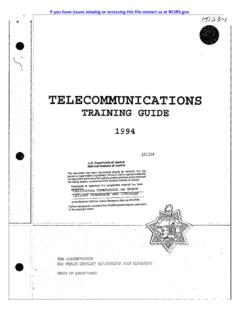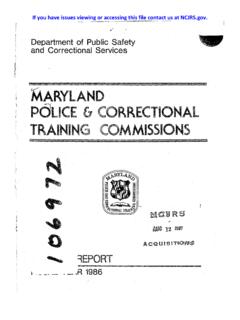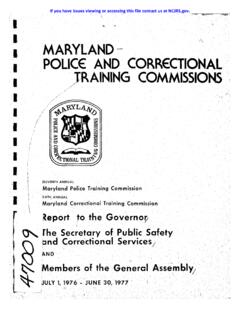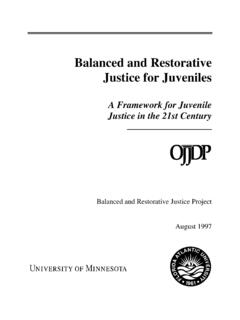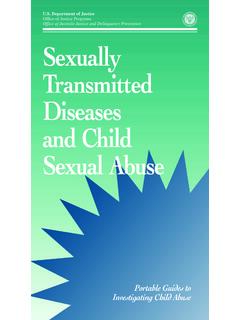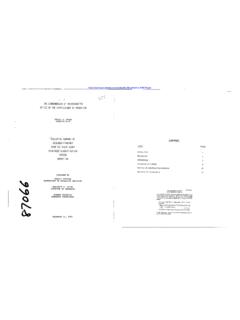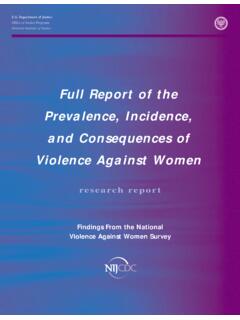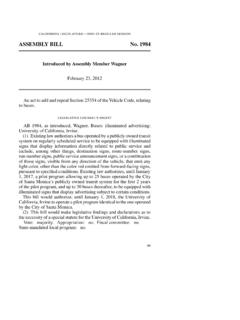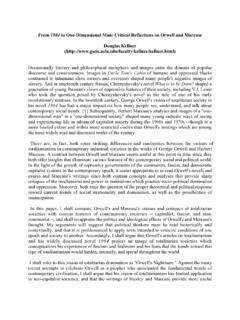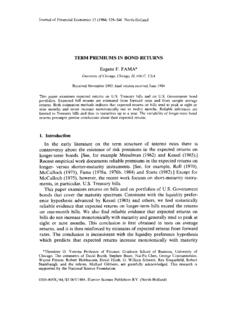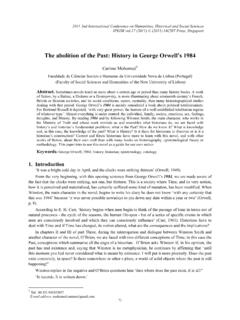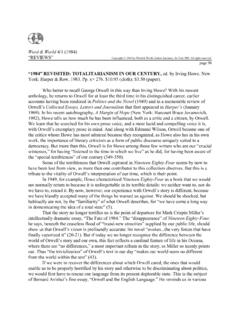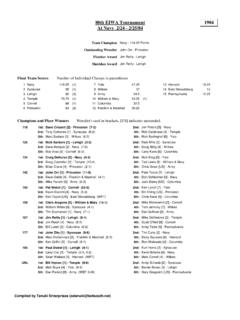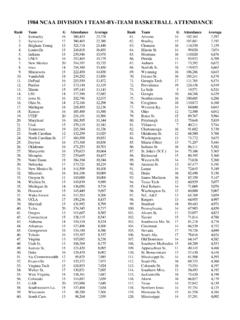Transcription of The Sentencing Reform Act of 1984 and Sentencing …
1 ,. ----. The Sentencing Reform Act of 1984 and Sentencing Guidelines The Untapped Potential for Judicial Discretion U~der the Federal Sentencing Guidelines: Advice for Counsel .. Gerald Bard Tioflat Flexibility and Discretion Available to the Sentencing Judge Guidelines Regime .. Edward R. Becker ng Guidelines: Two Views From the Bench tates Sentencing Commission: Andrew J. Kleinfeld G. Thomas Eisele . lissions .. lVilliam W. Wilkins, Jr. _ .. A 's View of the Sentencing Guidelines .. Thomas E. Zeno W ,,-~tice Under the Bail Reform Acts and the .. ;.. 19 Guidelines-A Shifting Focus .. : .. Daniel J. Sears ing Guidelines: What a Mess .. Jud:y Clarke 't' . Probation Officer: Life Before and Mter ~ Sentencing .. Jerry D. Denzlinger David E. Miller of the Sentencing Reform Act on anagement .. Mark H. Luttrell I, DECEMBER 1991 If you have issues viewing or accessing this file contact us at Department of Justice National Institute of Justice 136361-136371 This document has been reproduced exactly as received from the person or organization originating It.
2 Points of view or opinions stated In this document are those of the authors and do not necessarily represent the official po~ition or policies of the National Institute of Justice. Permission to reproduce this copyrighted material has been granted by Federal Probation to the National Criminal Justice Reference Service (NCJRS). Further reproduction outside of the NCJRS system requires permis-sion of the copyright owner. \ Federal Probation A JOURNAL OF CORRECTIONAL PHILOSOPHY AND PRACTICE Published by the Administrative Office of the United States Courts VOLUME LV DECEMBER 1991 This Issue in Brief APR tJ 199? YEARS FROM now, 1987-the year Sentencing guidelines went into effect-will be remem-bered as a milestone in Federal criminal jus-tice. The Sentencing Reform Act of 1984 which brought about the Sentencing guidelines sent ripples in the pool of the Federal court system that affected all who participate in the Sentencing process.
3 Cer-tainly the day-to-day work of judges, both district and appellate, prosecutors, attorneys, probation offi-cers, and correctional personnel has been altered sig-nificantly, and the course of careers has changed. This special issue of Federal Probation gives a voice to those who have been working in the midst of such historic change. Federal Probation invited eminent jurists and prominent Sentencing experts to prepare articles re-flecting their thoughts and perspectives regarding the Sentencing Reform Act and the Sentencing guidelines. The first three articles comprise thoughtful, varied perspectives from the bench. The articles that follow are by authors representing other critical roles in Sentencing . The articles are organized by profession in the order that each author would typically become involved in the Sentencing process. Ever since the Federal Sentencing guidelines went into effect, judges and commentators have criticized the guidelines for placing excessive restrictions on judicial discretion.
4 The Honorable Gerald Bard Tjoflat, chief judge ofthe Court of Appeals for the Eleventh Circuit, asserts that critics fail to appreciate the significant discretion that the judge retains. In 'The Untapped Potential for Judicial Discretion Under the Federal Sentencing Guidelines: Ad-vice for Counsel," Judge Tjoflat addresses the failure of attorneys to appropriately exploit judicial discretion within the guidelines structure. Advice for attorneys is offered regarding how to develop proper arguments to guide the Sentencing judge's discretion in a particu-lar case. Providing substantial background informa-tion, the article describes the congressional purposes of the Sentencing guidelines, the elements of guideline Sentencing , and the scope of judicial discretion embed-ded in the guidelines. 1 .A \.} ~ U H S fT' c" !\: ,~~ CONTENTS The Untapped Potential for Judicial Discretion Under the Federal Sentenci~ Guidelines: Advice for Counsel.
5 \. :;.. ~.t .. Gerald Bard Tjoflat 4 Flexibility and Discretion Available to the Sentencing Jud e Under the Guidelines Regime .. \ 3. (. B. ~ .. Edward R. Becker 10 The Sentencing Guidelines: Two Views From the Bench r3 b. 3. b 3 ..' .. Andrew J. Kleinfeld \ b C-\-G. Thomas Eisele 16 The United States Sentencing Commission: Its Many Missions \3l:.'3 t;,S William W. Wilkins, Jr. 26 A Prosecutor's View of the Sentencing Guidelines .. \. ' 3bb .. Thomas E. Zeno 31 Defense Practice Under the Bail Reform Acts and the Sentencing Guidelines-A Shifting Focus .. (.. Daniel J. Sears 38 The Sentencing Guidelines: Wha~Mess .. Judy Clarke 45 ~ <b ~ The Federal Probation Officer: Life Before and After Guideline Sentencing .. Jerry D. Denzlinger \ 3 63 bCf David E. Miller 49 The Impact of the Sentencing Reform Act on Prison Management .r3b.::3.. Mark H. Luttrell 54 Departments . \.9bo7~ Looklng at the Law.))
6 58 Your Bookshelf on Review .. 73 Indexes of Articles and Book Reviews .. 76 Featured in "Looking at the Law" .. Fact-Finding Under the Sentencing Guidelines Role of the presentence report Burden of persuasion in challenging the presentence report Role of negotiated stipulations Quality of evidence and standard of proof required to establish guideline-relevant facts d \ 3lo37D The Impact of the Sentencing Reform Act on Prison Management By MARK H. LUTl'RELL Warden, Federal Correctional Institution, Texarkana, Texas THE Sentencing Reform Act (SRA) of 1984 has significantly affected correctional man-agement in the Bureau of Prisons in a multi-tude of ways. On the surface, it would appear that the changes having the most impact would be those affecting inmates and inmate management. How-ever, this law has created ripple effects which have extended to management of human and material re-sources.
7 On the one hand, the disparity which ex-isted in the past in terms of Sentencing decisions has been diminished. There is now a strong level of pre-dictability in terms of time to be served which as-sists staff in planning for an inmate's period of incarceration and eventual release. Furthermore, the Bureau's inmate population has changed as a result of longer sentences with virtually no parole terms. These changes have profoundly altered the Bureau's inmate profile. Additionally, they have ne-cessitated an expansion of physical plants as well as prompted the Bureau to develop innovative means of housing inmates. Finally, the Bureau has experi-enced an unprecedented growth in staffing. Sentencing Disparity and Time Served Speaking on Sentencing disparity, Judge William W. Wilkins, Jr., in his opening address to the American Correctional Association's 1991 Winter Conference, mentioned an example of two brothers who committed the crime of larceny together and were sentenced to prison, but they happened to appear before different judges for that same crime.
8 One was sentenced to 1 year, and one was sentenced to 6 years. He also cited an example of a flrst offender who passed three coun-terfeit $5 bills and was sentenced to 15 years and another who passed four $20 bills who was a recidivist and was sentenced to 4 years. The SRA has removed such disparity and, in doing so, has dissipated some of the tensions inmates expe-rienced in the past. Under the old law, uncertainty of Statements contained in this article are the views of the author. Opinions expressed are not necessarUy those of the Federal Bureau of Prisons and should not be construed as such. This article was written as a collaborative effort of the author and the following sources, all affiliated with the Federal Bureau of Prisons: Hector Ledezma, Donald Roer-ick, and Jack Stone, all with the Federal Correctional Insti-tution, Texarkana, Texas, and Bill Burlington, deputy general counsel, Washington, DC, and Gerald Gaes, chief, Research and Evaluation, Washington, DC.
9 54 time to be served remained of paramount importance to inmates, ~wen after Sentencing , for two reasons. The first of these is that inmates were often angered and frustrated by disparities in Sentencing . The second is that inmates perceived the Parole Commission as the "real" Sentencing authority in that it was charged with making the decisions about who should be paroled to the community and the length of time for which they should be paroled. With Sentencing disparity eliminated, inmate con-cern about the issue is no longer evidenced. This has been of some benefit to prison managers in their day-to-day work. Another factor that has enhanced the management of inmates is the predictability of time to be sel" led, based on changes in sentence computation procedures. Typically, sentences begin once inmates are sentenced and placed in a facility while awaiting transportation to their designated facilities.
10 The Full Term Date or Maximum Release Date is then established by adding the term imposed by the court to the first day the defendant is placed in custody for service of his or her sentence. Time served in Federal custody in relation to the offense is credited towards the sentence, pro-vided it has not been credited to another sentence. Under the old law, this Full Term Date or Maximum Release Date was then reduced with the application of Statutory Good Time,l which was based on the length of the sentence imposed, to establish a Statutory Re-lease Date. Under the old law, this Statutory Good Time could be forfeited or withheld during incarcera-tion based on violation of rules and regulations within the institution. This deduction or forfeiture of Statu-tory Good Time could, after a predetermined required waiting period, be restored to the inmate. From this Statutory Release Date, institution staff would then deduct Industrial Good Time2 or Meritorious, Good Time,3 to determine a final time status.
